Tiananmen Square, the largest urban square in the world, located in central Beijing, spanning 440,000 square meters. It’s surrounded by iconic landmarks like Tiananmen Tower, the Monument to the People’s Heroes, the Great Hall of the People, and Chairman Mao Zedong Memorial Hall. The daily flag-raising ceremony draws thousands of visitors. As the heart of the city and a symbol of China, it’s a must-visit for anyone coming to Beijing.
Tiananmen Square Facts
- Location: Chang’an Street, Dongcheng District, Beijing, 100009, China
- Type: Historical Sites, Architectural Buildings, Square, Center Plaza, Landmarks
- Area: 440,000 m²
- Visiting Hours: 5:00 AM – 10:00 PM
- Recommended Visiting Time: Half a day
- Tickets: Free for Square
Located in the Dongcheng District, Tiananmen Square, measuring 880 meters long and 500 meters wide, was formed in the Ming Dynasty and significantly expanded in the 20th century. It highlights the symmetrical layout principle of Beijing’s central axis and showcases China’s mid-20th-century exploration of national architectural styles. Home to landmarks like the Great Hall of the People and the National Museum of China, it serves as a venue for key national events and ceremonies, symbolizing the continuity of national culture and heritage.
Top Attractions Around Tiananmen Square
Tiananmen Tower
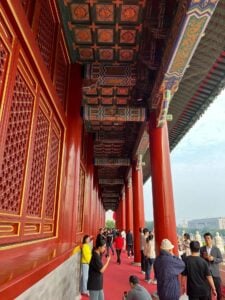
Tiananmen Tower, first built in 1417 during the Ming Dynasty, was originally the main gate of the Forbidden City. It was used to announce imperial edicts and was only opened for major ceremonies like coronations, weddings, and rituals honoring heaven and earth.
Standing 33.7 meters high, the tower has 60 large columns and a throne-style platform. Its design includes golden brick floors, ornate doors, and beams decorated with traditional Chinese patterns symbolizing good fortune. The central arched door was once reserved for the emperor only.
Today, the tower displays a large portrait of Chairman Mao Zedong with slogans praising the People’s Republic of China and global unity. The Jinshui River flows in front of the tower, with historic bridges crossing it. Located at the north end of Tiananmen Square, it remains a powerful symbol of China’s rich history and cultural heritage.
Monument to the People’s Heroes
The Monument to the People’s Heroes stands at the center of Tiananmen Square. Construction began on August 1, 1952, and was completed in April 1958. It is the largest monument in Chinese history.
The monument is 37.94 meters high and built with over 17,000 pieces of granite and white marble. It includes platforms, sumeru thrones, a central body, and a top structure. The front bears the inscription “Immortal People’s Heroes,” written by Chairman Mao Zedong in golden characters.

The back of the monument features a inscription drafted by Mao Zedong and calligraphed by Zhou Enlai. Decorative reliefs show key moments in China’s modern history. Designed by Liang Sicheng and others, the monument honors those who fought for national independence and freedom. It reflects traditional Chinese art and serves as a lasting symbol of respect for revolutionary heroes.
Great Hall of the People
The Great Hall of the People, located west of Tiananmen Square, was built in just over 10 months and completed in September 1959. It is the main site for China’s National People’s Congress and other major political events.
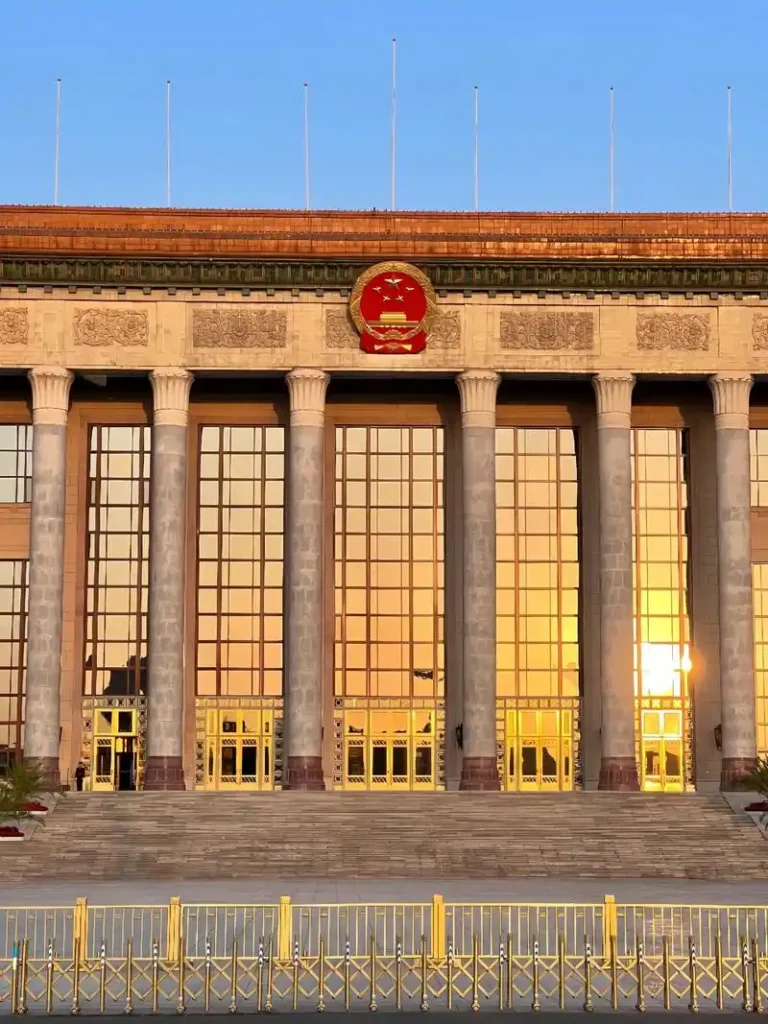
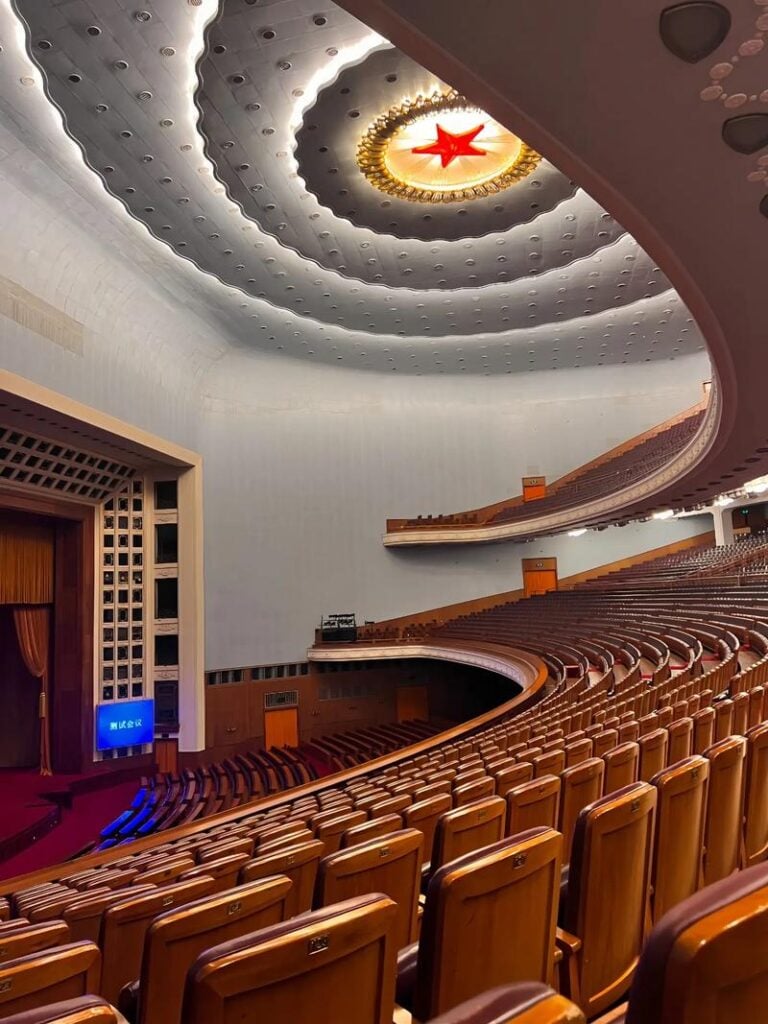
Covering 170,000 square meters, the Hall combines traditional Chinese style with Western architectural elements. It has 134 columns, 12 tall marble gateposts at the front, a peach-colored marble floor, and crystal lamps. The building includes the Central Hall, a 10,000-seat auditorium, and a banquet hall for 5,000 guests. As the top state organ’s meeting place, it plays a key role in national governance and ceremonies.
Memorial Hall of Chairman Mao
Chairman Mao Memorial Hall is located in Tiananmen Square. It has an exterior area of 5.72 square meters and a total construction area of 33,867 square meters. It was built in November 1976 and opened to the public on September 9, 1977.
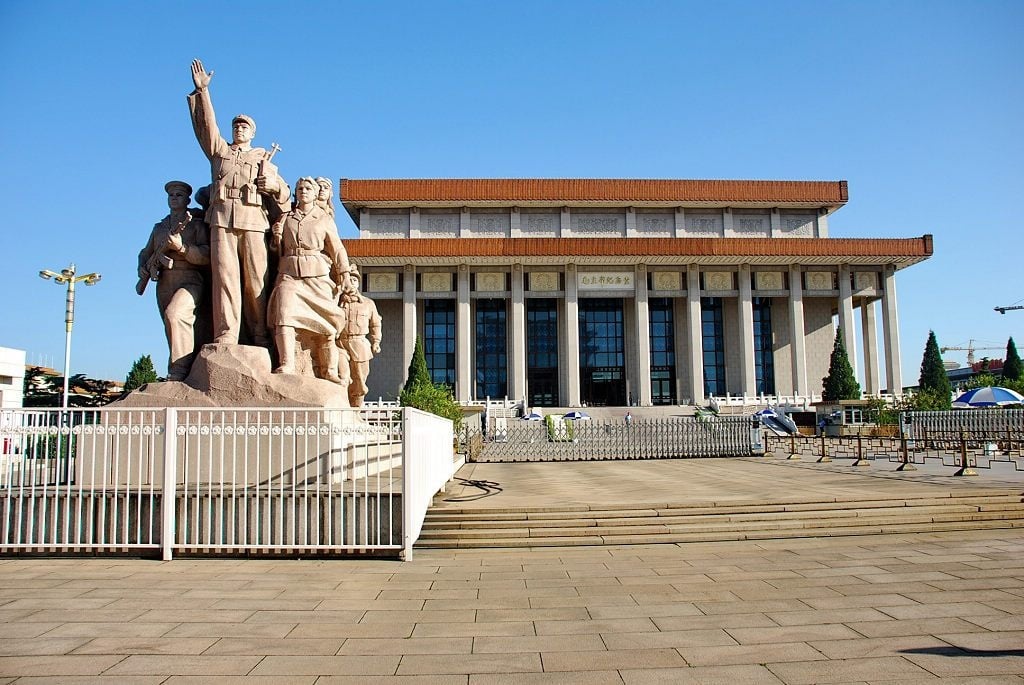
The memorial hall consists of the North Corridor, the Memorial Hall and the South Hall. The Memorial Hall is in the center and is the place to pay homage to Mao Zedong’s remains. The North Hall is a lifelike white marble statue of Chairman Mao, and next to it is an exquisite scroll painting depicting the beautiful landscape of China. The South Hall exhibits Mao Zedong’s literary achievements.
There are six revolutionary art exhibition halls on the second floor, which display photos, documents and cultural relics about China’s revolutionary leaders and history.
National Museum of China
Located on the east side of Tiananmen Square, the National Museum of China was established in 2003 by combining the Chinese History Museum and the Chinese Revolutionary Museum. It showcases China’s long history and rich culture through a vast collection of relics, artifacts, books, and models. The museum is especially known for its “Ancient China” exhibition, featuring over 2,000 cultural relics, including many national treasures. With its focus on history, art, research, and public education, it has become one of the world’s most popular and comprehensive museums.
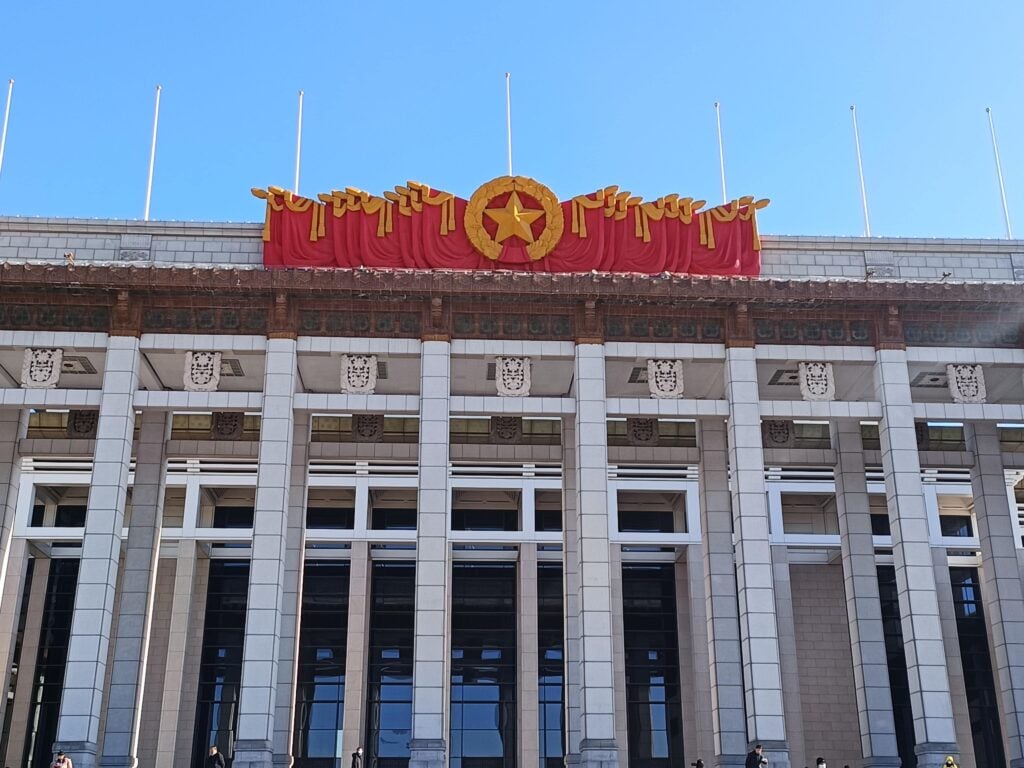
Flag-Raising Ceremony
The flag-raising ceremony at Tiananmen Square is a must-see for visitors to Beijing. The Chinese national flag, the Five-Star Red Flag, is raised daily by an honor guard. To get a good view, it’s best to arrive before sunrise, as large crowds gather for the event. The ceremony time varies with the season, usually between 4:40 AM and 7:40 AM. Since 2012, the viewing stands on both sides of Tiananmen Tower have been open to the public for free. Group reservations are available for the first day of each month if you wish to watch the ceremony in a more organized setting.
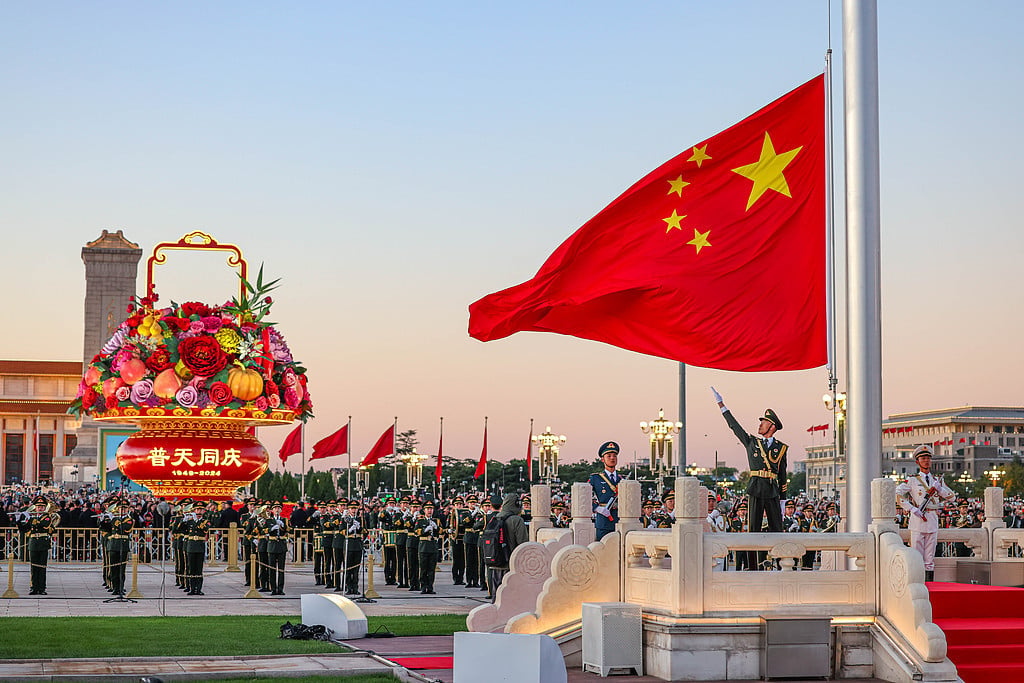
How to Get to Tiananmen Square
By Subway
- Take Metro Line 1 to East Tiananmen or West Tiananmen Station.
- Take Metro Line 2 to get off at Qianmen. Get out from Exit A or B and walk north.
By Bus
- Take bus 1, 5, 52, Sightseeing Bus Line 1, Sightseeing Bus Line 2, and get off at West Tiananmen.
- Take bus 1, 2, 52, 82, 120, Sightseeing Bus Line 1&2 to East Tiananmen.
- Take bus 2, 5, 120, or Sightseeing Bus Line 1&2, and get off at East Tiananmen Square.
- Take bus 2, 120 or Sightseeing Bus Line 1&2 to West Tiananmen Square.
- Take bus 22, 82, 137 or 599 to Qianmen East Station, then walk north to Tiananmen Square.
Distances to Popular Attractions in Beijing
- From the Forbidden City – about 1 km (approximately 15 minutes walking)
- From the Temple of Heaven – about 4 km (approximately 25 minutes driving)
- From the Summer Palace – about 18 km (approximately 38 minutes driving)
- From the Badaling Great Wall – about 75 km (approximately 1 hour and 50 minutes driving)
Opening Hours & Tickets Price
| Attractions | Opening Hours | Admission Fee |
| Tiananmen Square | 05:00-22:00 | Free |
| Great Hall of the People | 08:15 – 15:00 (Spring) 07:30 – 16:00 (Summer) 08:30-15:00 (Autumn) 09:00-14:00 (Winter) | Free |
| Mao Zedong Memorial Hall | 08:00 – 12:00 (Tuesday – Sunday) | Free |
| National Museum of China | 9:00 – 17:00 (Tuesday – Sunday) | Free |
Tiananmen Square Tour Route
If you wish to watch the flag-raising ceremony, we recommend this tour route that allows you to efficiently explore key landmarks in Tiananmen Square.
Flag-Raising Ceremony -> Chairman Mao Memorial Hall -> Monument to the People’s Heroes -> National Museum of China
Arrive at Tiananmen Square about two hours early to secure a good viewing spot. The ceremony is an essential part of experiencing the square’s atmosphere.
After the flag-raising, walk south along the square to visit the Chairman Mao Memorial Hall. Remember to store your bags at the designated area on the east side before entering the square. Admission is free but requires online pre-booking with real-name registration. Be prepared for a queue and keep visits brief (around 30 seconds). Show respect by removing hats and not taking photos inside.
From the Memorial Hall, head towards the center of the square to see the Monument to the People’s Heroes. This monument commemorates those who died during the struggles to achieve national freedom and independence.
Finally, proceed to the eastern side of the square to visit the National Museum of China. It’s vast, so plan to spend at least half a day if you wish to explore comprehensively. If time is limited, focus on exhibits that interest you most.